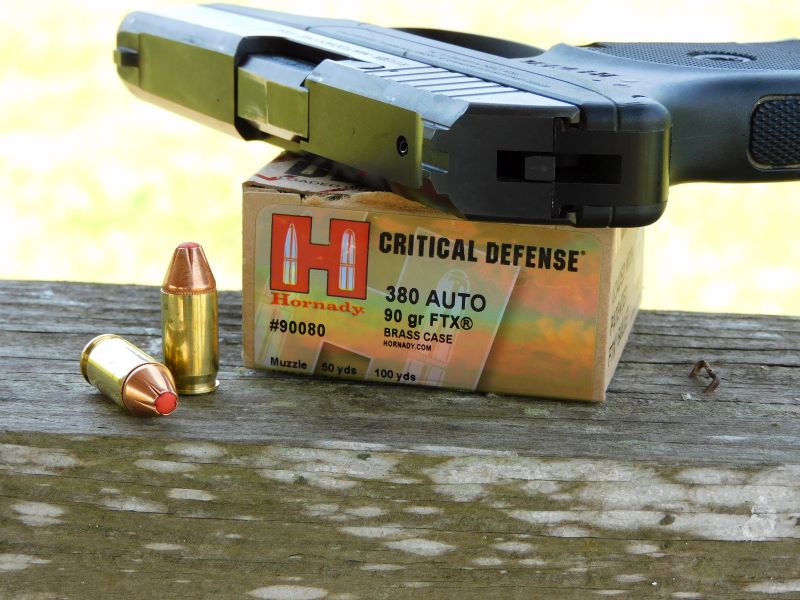When it comes to 380 ACP, ammunition selection can be dicey. Defensive hollow point ammunition in that caliber falls into two categories: those that work too well and those that don’t work well enough. Some expand beautifully but get little penetration. Most fail to expand coming out of typical pocket pistols and zip through the target like nonexpanding full metal jacket ammo. I long ago gave up on the quest to find the best 380 ACP load and I generally will carry traditional full metal jacket loads. However, that doesn’t mean you should discount the few 380 loads that actually work. Case in point: Hornady Critical Defense 90-grain FTX load.

The Hornady Critical Defense Explained
Most .380 hollow points use a traditional copper jacketed round with an exposed lead cavity. Hornady’s Critical Defense line spans from calibers as small as 25 ACP to 45 ACP. It uses a jacketed lead hollow point with a red polymer tip inserted in the cavity. Both on the street and in ballistic gelatin, traditional hollow points can become stuffed with clothing or denim and fail to expand as the round slows down.
The Hornady Critical Defense’s FTX projectile essentially comes pre-stuffed. The red tip prevents denim from clogging the cavity and it acts as a wedge in tissue. The cavity is smaller and the round is truncated in shape, allowing it to feed in guns that might hang up on traditional wide-faced hollow-points. The 380 ACP Hornady Critical Defense load uses a 90-grain FTX bullet. Unlike other premium hollow points, this load uses plain brass cases. Otherwise, it looks like any other round in the Critical Defense lineup.
Velocity Test
The faster you propel a hollow-point bullet, the more the possible upset. Generally, the longer the barrel, the more velocity imparted to the projectile. In larger handguns, the 380 ACP Critical Defense load delivers uniform expansion while delivering moderate penetration. But most folks are carrying shorter barreled pocket handguns that can hobble rounds that otherwise look good.
I used my trusty Ruger LCP to test the Critical Defense load. I fired five rounds over my Caldwell Chronograph. Out of the 2¾ inch barrel of the LCP, the Hornady load clocked in at an average velocity of 902 feet per second. By 380 hollow-point standards, that is low speed. Out of the same gun, the heavier 99-grain Federal Micro HST clocked in at 959 feet per second. The comparable Speer Gold Dot 90-grain hollow-point ran at 968 feet per second. But the reading was not a fluke. In a previous test with the same pistol, a different box ran at 929 feet per second — still slow compared to the other slowpoke rounds.
Gelatin Test

I fired four rounds of the Hornady Critical Defense load into ballistics gelatin blocks from 10 feet. The blocks are Clear Ballistics 10% ordinance blocks to simulate muscle tissue. The blocks are fronted with four layers of denim to simulate heavy clothing or shooting through the arm of a long-sleeved jacket as well as the clothing on the preferred part of the target.

Like most 380 rounds, the Critical Defense projectiles tumbled. This resulted in half-inch stretch cavities between the three- to eight-inch mark as the rounds destabilized after hitting the denim and entering the gelatin. From there, the rounds slowed down. One round escaped the block. The other three were captured. All of them caught some denim on the way in, with one round’s petals expanding and losing its red tip. That round stopped after 14 inches of penetration. The other two rounds landed base first and unexpanded at 15¾ and 17½ inches respectively.

This recent test had some interesting overlap with one I conducted several years before. In that test with the same medium and same handgun, one round shot to 20½ inches. Two other rounds achieved uniform expansion and penetrated to 16 inches. As seen in the new test, those rounds caught denim, lost their tips, and achieved a uniform expansion of .43 inches.

Parting Shots
Compared to higher velocity duty rounds like the 9mm Luger, the Hornady Critical Defense 380 is middling. Some expansion is expected. To see no expansion in some sample sizes can be troubling. But in the context of ammunition performance out of 380 ACP pocket pistols, the Hornady Critical Defense is one of the loads to beat. Although there will be some variation from one lot to the next, this load delivers some expansion, and those expanded projectiles go far beyond the typical eight or nine inches a more typical expanded .380 round can achieve. The optimist in me says that eight to nine inches discounting bone is probably fine. But the Hornady Critical Defense offers 14-16 inches of penetration and expansion. This gives the self-defender vital performance when a textbook shot is impossible, and life is on the line.

